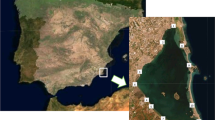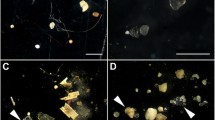Abstract
The rationale for the use of combined tissue residue chemistry and physiological energetics measurements of Mytilus edulis in the assessment and monitoring of environmental pollution is outlined. Laboratory derived relationships between the concentration of toxicants in tissues and sublethal responses (eg. feeding, respiration and growth rate) provide a toxicological database for the interpretation of physiological responses measured in the field. The role of quantitative structure-activity relationships (QSAR's) in establishing tissue concentration-effect relationships for organic contaminants is discussed. The application of this approach is illustrated with reference to two field studies, a monitoring programme in the Shetlands and a practical biological effects workshop in Oslo.
Similar content being viewed by others
References
Bayne, B. L., 1976. Marine mussels, their ecology and physiology. Cambridge University Press, Cambridge: 506 pp.
Bayne, B. L., K. R. Clarke & J. Gray (eds.), 1988. Biological Effects of Pollutants: Results of a practical workshop. Mar. Ecol. Prog. Ser. 46 (Special Volume). 278 pp.
Donkin, P., J. Widdows, S. V. Evans, C. M. Worrall & M. Carr, 1989. Quantitative structure-activity relationships for the effect of hydrophobic organic chemicals on rate of feeding by mussels (Mytilus edulis). Aquatic. Toxicol. 14: 185–222.
Farrington, J. W., E. D. Goldberg, R. W. Riseborough, J. H. Martin & V. T. Bowen, 1983. US ‘mussel watch’ 1976–1978: an overview of the trace-metal, DDE, PCB, hydrocarbon and artificial radionuclide data. Envir. Sci. Technol. 17: 490–496.
Hermens, J. L. M., 1986. Quantitative structure-activity relationships in aquatic toxicology. Pestic. Sci. 17: 287–296.
Kaiser, K. L. E. (Ed.) 1987. QSAR in environmental toxicology II. D. Reidel Publishers, Dordrect: 465 pp.
Köneman, H., 1980. Structure-activity relationships and additivity in fish toxicities of environmental pollutants. Ecotoxicol. Envir. Saf. 4: 415–421.
Skei, J., 1981. The entrapment of pollutants in Norwegian fjord sediments — a beneficial situation for the North Sea. Spec. Publ. int. Ass. Sediment 5: 461–468.
Sloof, W., J. W. Canton & J. L. M. Hermens, 1983. Comparison of the susceptibility of 22 freshwater species to 15 chemical compounds. I. (Sub) acute toxicity tests. Aquat. Toxicol. 4: 113–128.
Turner, L., F. Choplin, P. Dugard, J. Hermens, R. Jaeckh, M. Marsmann & D. Roberts, 1987. Structure-activity relationships in toxicology and ecotoxicology: An assessment. Toxic. in vitro. 1: 143–171.
Widdows, J., 1985. Physiological measurements. In: B. L. Bayne et al., (eds.), The effects of stress and pollution on marine animals. Praeger Press, New York: pp. 3–45.
Widdows, J., D. K. Phelps & W. Galloway, 1981. Measurement of physiological condition of mussels transplanted along a pollution gradient in Narrangansett Bay. Mar. Envir. Res. 4, 181–194.
Widdows, J., T. Bakke, B. L. Bayne, P. Donkin, D. R. Livingstone, D. M. Lowe, M. N. Moore, S. V. Evans & S. L. Moore, 1982. Responses of Mytilus edulis on exposure to the water-accommodated fraction of North Sea oil. Mar. Biol. 67: 15–31.
Widdows, J., P. Donkin, P. N. Salkeld & S. V. Evans, 1987a. Measurement of scope for growth and tissue hydrocarbon concentrations of mussels (Mytilus edulis) at sites in the vicinity of the Sullom Voe oil terminal: — a case study. In: J. Kuiper & W. J. Van den Brink (eds.), Fate and effects of oil in marine ecosystems. Martinus Nijhoff, Dordrecht: pp. 269–277.
Widdows, J., P. Donkin & S. V. Evans, 1987b. Physiological responses of Mytilus edulis during chronic oil exposure and recovery. Mar. Envir. Res. 23: 15–32.
Widdows, J. & D. Johnson, 1988. Physiological energetics of Mytilus edulis: Scope for Growth. Mar. Ecol. Prog. Ser. 46: 113–121.
Author information
Authors and Affiliations
Rights and permissions
About this article
Cite this article
Widdows, J., Donkin, P. The application of combined tissue residue chemistry and physiological measurements of mussels (Mytilus edulis) for the assessment of environmental pollution. Hydrobiologia 188, 455–461 (1989). https://doi.org/10.1007/BF00027813
Issue Date:
DOI: https://doi.org/10.1007/BF00027813




